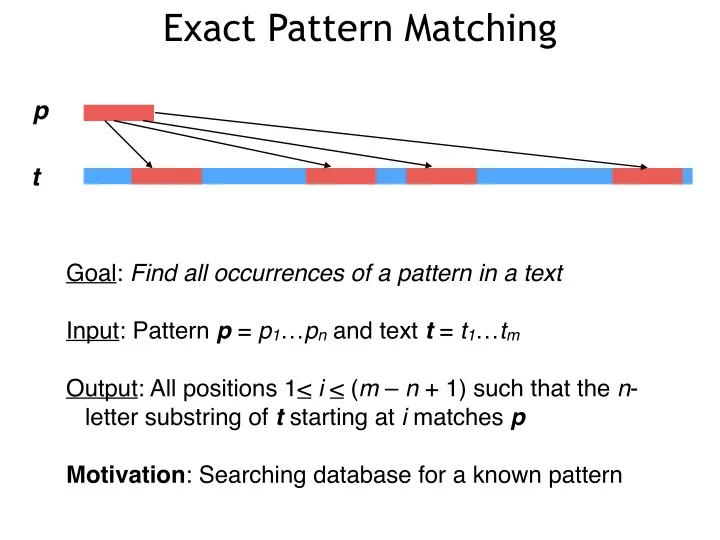

Exact Pattern Matching p t Goal: Find all occurrences of a pattern in a text Input: Pattern p = p 1 … p n and text t = t 1 … t m Output: All positions 1< i < ( m – n + 1) such that the n - letter substring of t starting at i matches p Motivation : Searching database for a known pattern
Pattern Matching: Running Time • Naïve runtime: O(nm) • How? • On average, it should be close to O(m) • Why? • Can solve problem in O(m) time ? • Yes, we’ll see how (in a later lecture)
Multiple Pattern Matching p 1 p 2 t Goal: Given a set of patterns and a text, find all occurrences of any of patterns in text Input: k patterns p 1 ,…, p k , and text t = t 1 …t m Output: Positions 1 < i < m where substring of t starting at i matches p j for 1 < j < k Motivation: Searching database for known multiple patterns
Multiple Pattern Matching • Solution: k “pattern matching problems”: O(kmn) • Another Solution: • Using “Keyword trees” => O(kn+nm) where n is maximum length of p i • Preprocess all k patterns to construct a “keyword tree” • Now, any given text, all occurrences of all patterns can be found in time O(m)
Keyword tree approach
Keyword tree approach: Properties
Keyword tree: Construction
Keyword tree: Lookup of a string How to check all occurrences in a text t ?
Keyword tree approach: Complexity • Build keyword tree in O(kn) time; kn is total length of all patterns • Start “threading” at each position in text; at most n steps tell us if there is a match here to any p i • O(kn + nm) • We’re down from O(kmn) to this • The next big idea, Aho-Corasick algorithm: O(kn + m)
Aho-Corasick algorithm: Key idea Exploit the redundancy in the patterns HERSHE HERS SHE HE
Aho-Corasick algorithm: Key idea Exploit the redundancy in the patterns HERSHE HERS SHE HE
Aho-Corasick algorithm With failing edges and node labels
Rules • Transition among the different nodes by following edges depending on next character seen (say “h”) • If outgoing edge with label “h”, follow it • If no such edge, and are at root, stay • If no such edge, and at non-root, follow dashes edge (“fail” transition); DO NOT CONSUME THE CHARACTER (say “h”) Consider text “ hershe ”
Aho-Corasick algorithm
Aho-Corasick algorithm Add pattern labels
Adding failing edges • If currently at node q representing word L(q), find the longest proper suffix of L(q) that is a prefix of some pattern, and go to the node representing that prefix. Insert the labels of the pointed node (if there is any) to node q’s set of labels. • Example: node q = 5, L(q) = she; longest proper suffix that is a prefix of some pattern: “he”. Dashed edge to node q’=2
Aho-Corasick Algorithm Add Failing Edges and Labels
Aho-Corasick Algorithm: Construction What about a naive algorithm?
A better algorithm: intuition Suppose we already know the failing edge from a node w to x . If we follow a solid edge with label a , there are two possibilities:
A better algorithm: intuition Suppose we already know the failing edge from a node w to x . If we follow a solid edge with label a , there are two possibilities:
A better algorithm: intuition Suppose we already know the failing edge from a node w to x . If we follow a solid edge with label a , there are two possibilities:
Constructing failing edge for a node • To construct the failing edge for a node wa : • Follow w 's failing edge to node x . • If node xa exists, wa has a failing edge to xa . • Otherwise, follow x 's failing edge and repeat. • If you need to follow all the way back to the root, then wa ’s failing edge points to the root. • Observation 1: Failing edges point from longer strings to shorter strings. • Observation 2: If we precompute failing edges for nodes in ascending order of string length, all of the information needed for the above approach will be available at the time we need it.
Complexity • Focus on the time to fill in the failing edges for a single pattern of length n . • The failing edges moves one-step backward because it always points to a shorter string. • The solid edges moves one-step forward. • We cannot take more steps backward than forward. Therefore, across the entire construction, we can take at most n steps backward for this pattern. • Total time required to construct failing edges for a pattern of length n: O(n). • Total time required to construct failing edges for all k patterns: O(kn).
Recommend
More recommend